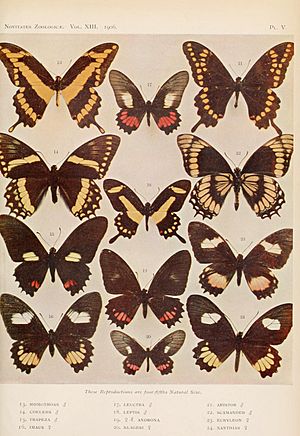False giant swallowtail facts for kids
Quick facts for kids False giant swallowtail |
|
|---|---|
 |
|
| This picture shows the butterfly when it was first described (figure 13). | |
| Scientific classification |
The false giant swallowtail (scientific name: Papilio homothoas) is a beautiful type of swallowtail butterfly. You can find this butterfly in several countries in South and Central America. These include Colombia, Venezuela, Trinidad, Panama, and Costa Rica. It was first officially described in 1906 by two scientists, Walter Rothschild and Karl Jordan.
Contents
What is a Swallowtail Butterfly?
Swallowtail butterflies are a large family of butterflies. They are known for their bright colors and often have "tails" on their hindwings. These tails look a bit like the tails of swallow birds. The false giant swallowtail belongs to the Papilio genus. This genus includes many large and striking butterflies.
Where Does it Live?
The false giant swallowtail prefers warm, tropical areas. It lives in rainforests and other green, lush places. These habitats provide plenty of plants for the butterflies to feed on. They also offer safe places for them to lay their eggs.
What Does it Look Like?
Like many swallowtails, the false giant swallowtail is quite large. It has wings that are usually dark. They often have bright markings in shades of yellow, orange, or blue. These patterns help them blend in or warn predators. The "false giant" part of its name might suggest it looks like another, even larger butterfly.
Life Cycle of the False Giant Swallowtail
Like all butterflies, the false giant swallowtail goes through a complete metamorphosis. This means it changes a lot during its life.
Egg Stage
The life cycle begins when the female butterfly lays tiny eggs. She usually places them on specific plants. These plants are called "host plants." They will be the first food for the caterpillars.
Larva (Caterpillar) Stage
Once the eggs hatch, a small caterpillar emerges. This caterpillar is the larva stage. Its main job is to eat and grow. Caterpillars eat a lot of leaves from their host plants. They grow quickly and shed their skin several times. This process is called molting.
Pupa (Chrysalis) Stage
After growing big enough, the caterpillar forms a chrysalis. This is the pupa stage. Inside the chrysalis, amazing changes happen. The caterpillar's body transforms into a butterfly. This stage can last for weeks or even months.
Adult Butterfly Stage
Finally, the adult false giant swallowtail butterfly emerges from the chrysalis. Its wings are soft at first. It needs time for them to harden before it can fly. Once ready, the adult butterfly will fly around. Its main goals are to find food and to reproduce.
What Do They Eat?
Adult false giant swallowtails drink nectar from flowers. Nectar is a sweet liquid that gives them energy. They use their long, straw-like mouthpart, called a proboscis, to sip the nectar. Caterpillars, on the other hand, eat the leaves of their host plants. The specific plants they eat are important for their survival.
Why Are Butterflies Important?
Butterflies like the false giant swallowtail play a key role in nature.
Pollination
As they fly from flower to flower, butterflies help with pollination. They carry pollen from one plant to another. This helps plants make seeds and fruits. Pollination is very important for many plants, including those that produce food for humans.
Part of the Food Web
Butterflies and their caterpillars are also a food source for other animals. Birds, lizards, and even some insects eat them. This makes them an important part of the food web in their ecosystems.
Conservation
Many butterfly species face challenges today. These include habitat loss and climate change. Protecting the places where butterflies live is very important. This helps ensure that beautiful species like the false giant swallowtail can continue to thrive for future generations.
See also
 In Spanish: Papilio homothoas para niños
In Spanish: Papilio homothoas para niños

